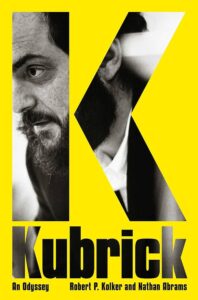By ROBER P. KOLKER, NATHAN ABRAMS (Pegasus Books; 2024)
This book has been proclaimed the definitive biography of the great Stanley Kubrick, and for once the hype is correct. As of 2024, KUBRICK: AN ODYSSEY can indeed be proclaimed the most authoritative Kubrick bio in existence, it being, if nothing else, the only such book (others include Vincent LoBrutto and John Baxter authored bios, both of which appeared in 1997) to be written after Kubrick’s death, and the release of his final film EYES WIDE SHUT, in 1999. Yet Robert P. Kolker and Nathan Abrams also uncover details not found in any other Kubrick biography and have turned out an extremely gripping read in the bargain.
Kubrick’s early years were colorful ones. He grew up, like Woody Allen, Neil Simon and Mel Brooks, in depression-era New York, albeit in a more affluent family then those other men. His school years were unimpressive, with Kubrick, an intense but fundamentally good-natured fellow, foregoing college in favor of employment as a still photographer for LOOK magazine, where he learned the fundamentals of lighting and framing. In his early twenties Kubrick switched his focus to filmmaking, and after making a couple short films directed his first feature, the no-budget FEAR AND DESIRE (1952).
A monumental debut that film wasn’t. In fact, it took Kubrick until his third feature, THE KILLING (1956), to really hit his filmmaking stride. By that point, as this book makes clear, his bad habits (which even the most fawning Kubrick fanatic must acknowledge) had already begun to make themselves apparent. Those habits, which fought against his kind nature, included denying his collaborators (screenwriters in particular) their rightful credit, and only grew increasingly prevalent as he aged.
In many respects the Kubrick saga is a tragic one, and a cautionary presentation of the dark side of fame. A rock star Kubrick wasn’t, but he did receive a disproportionate amount of approbation that led him down some dark paths. Rather than abandon himself to excess, the family-oriented Kubrick became increasingly unapproachable and hermetic. In his later years his personal hygiene laxed, as did his grasp of common courtesy; he rarely ever bothered saying “thank you” and expected everyone to upend their lives in order to serve his needs (and had enormous trouble fathoming why they wouldn’t).
What’s undeniable is that Kubrick turned out some of the greatest films ever made. His insanely exacting methodology, which entailed exorbitant research, seemingly endless retakes and a careful juxtaposition of preparation and improvisation (which according to this book was a mainstay of Kubrick’s filmmaking) yielded results without question.
This book tells it all with erudition, intelligence and admirable bluntness. Its subject is explored thoroughly, and while the coverage of his films can’t hope to complete with the books devoted to them (such as Michael Benson’s SPACE ODYSSEY and EYES WIDE SHUT: STANLEY KUBRICK AND THE MAKING OF HIS FINAL FILM by this book’s authors), Kolker and Abrams succeed in providing solid overviews that will likely inspire receptive readers to delve deeper.

